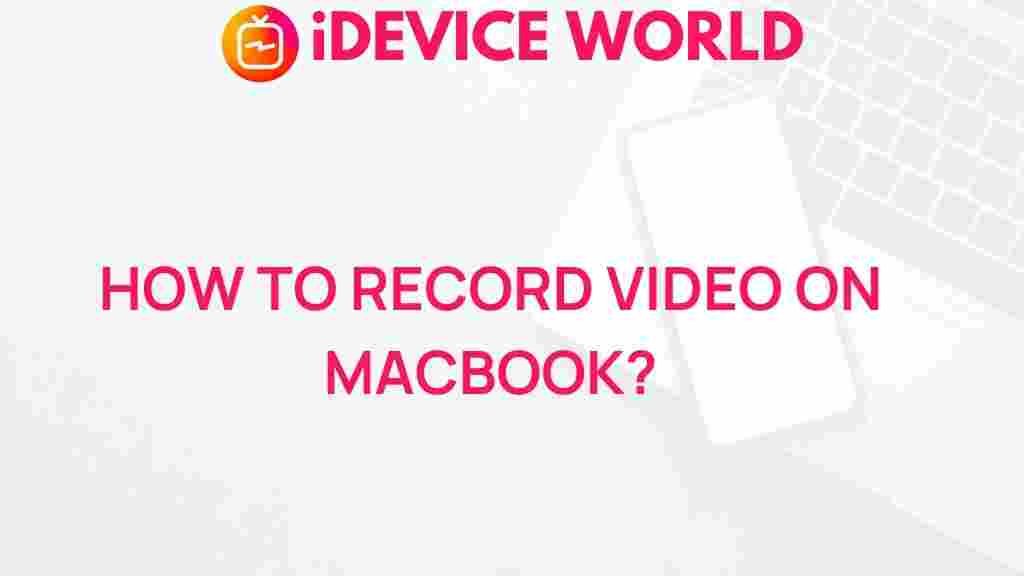Video Recording: Unleash Your Creativity
In today’s digital age, video recording has become an essential skill for creators, marketers, and anyone looking to share their ideas with the world. Whether you are creating content for YouTube, recording webinars, or capturing precious moments with family and friends, mastering video recording on your MacBook can significantly enhance the quality of your videos. This article will guide you through the process, offering tips, tools, and troubleshooting advice to help you unleash your creativity through effective video recording.
Why Video Recording is Important
Video recording is more than just capturing moving images; it’s a powerful medium for storytelling and communication. Here are some reasons why mastering this skill is crucial:
- Engagement: Video content is known to engage viewers more than text or images.
- Versatility: You can use video for various purposes, from personal projects to professional marketing.
- Accessibility: With the rise of social media platforms, video recording has never been more accessible.
Getting Started with Video Recording on Your MacBook
Before diving into the technical aspects, it’s essential to understand what tools and software you’ll need for effective video recording on your MacBook.
Essential Tools for Video Recording
- Camera: Your MacBook’s built-in camera is sufficient for basic recordings. However, for higher quality, consider an external webcam.
- Microphone: Audio quality is crucial. Invest in a good quality microphone for clear sound.
- Lighting: Proper lighting enhances video quality. Use natural light or purchase softbox lights.
- Video Recording Software: Applications like QuickTime Player, iMovie, or third-party options like OBS Studio and ScreenFlow can help you record and edit your videos.
Step-by-Step Guide to Video Recording on Your MacBook
Step 1: Setting Up Your Workspace
Choose a quiet, well-lit area for your recording. Arrange your background to minimize distractions. Make sure your MacBook is fully charged or plugged in to avoid interruptions.
Step 2: Choosing Your Software
For beginners, QuickTime Player is an excellent choice due to its simplicity. Here’s how to use it:
- Open QuickTime Player from your Applications folder.
- Click on “File” in the menu bar and select “New Movie Recording.”
- Choose your camera and microphone settings by clicking the arrow next to the record button.
- Press the red record button to start filming.
Step 3: Recording Your Video
Keep the following tips in mind while recording:
- Frame Yourself: Position yourself in the center of the frame. Ensure your face is well-lit.
- Speak Clearly: Use a clear and engaging tone. Test your audio levels before starting.
- Stay Focused: Avoid distractions during your recording session.
Step 4: Editing Your Video
After recording, it’s time to edit. iMovie is a user-friendly option that comes pre-installed on your MacBook. Here’s how to edit:
- Open iMovie and create a new project.
- Import your recorded video file.
- Use the editing tools to trim, split, and add effects or transitions.
- Export your final video by clicking on “File” and selecting “Share.”
Troubleshooting Common Video Recording Issues
Issue 1: Poor Video Quality
If your video looks grainy or blurry, ensure that you are using proper lighting and that your camera lens is clean. Consider recording in a resolution that matches your intended use.
Issue 2: Audio Issues
If your audio is unclear, check your microphone settings. Make sure you are using the correct input device and that it is positioned close enough to capture your voice effectively.
Issue 3: Software Crashes
To avoid software issues, keep your applications updated. If a program crashes, try restarting your MacBook and reopening the software. Always save your work frequently.
Enhancing Your Video Skills
Once you have mastered the basics, consider expanding your skills with these resources:
- Online courses on platforms like Udemy or Coursera.
- YouTube tutorials for specific techniques and tips.
- Practice regularly to improve your video recording and editing skills.
Conclusion
Mastering video recording on your MacBook opens up a world of creative possibilities. By following the steps outlined in this guide and continually honing your skills, you can produce high-quality videos that effectively communicate your message and engage your audience. Remember, the key to successful video recording is practice and experimentation.
For more tips on video recording and editing, visit our blog. For advanced techniques and software recommendations, check out this external resource.
Now is the time to unleash your creativity and start recording!
This article is in the category Guides & Tutorials and created by iDeciveWorld Team
